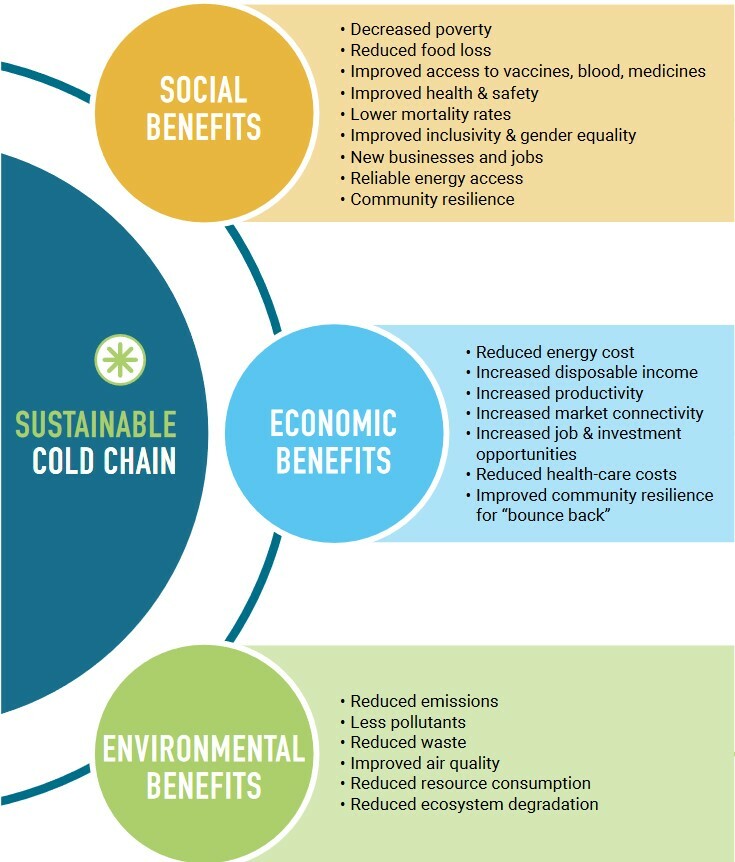Meeting the challenge of a sustainable global food cold chain
A recent report published by UNEP and FAO includes several important recommendations on how to develop more sustainable food cold chains.
According to the Food and Agriculture Organization (FAO), 31% of human-caused GHG emissions, originate from the world’s agri-food systems.[1] According to IIR estimates, 12% of food produced globally in 2017 was lost due to an insufficient cold chain. It has been estimated that the food cold chain is responsible for around 4% of total global greenhouse gas emissions, including emissions from cold chain technologies and from food loss and waste due to lack of refrigeration.[2, 3] A more extensive cold chain would limit the need to increase agricultural production to compensate for these losses and avoid the corresponding CO2 emissions.[3]
The Global Cold Chain Alliance (GCCA) estimates that the world’s refrigerated warehouse capacity grew 16.7% between 2018 and 2020, mostly in North America and China. Unfortunately, many developing countries still need substantial additional capacity to meet their cold chain needs.[2] Solutions are therefore needed both to reduce emissions from the global food cold chain and to make this infrastructure more environmentally sustainable.
In a recent report published by UNEP and the FAO, the authors explore how food cold chain development can become more sustainable and make a series of important recommendations.[2] A wide range of technologies, projects, financial and business models, local and international policies can be used to design sustainable food cold chains, while taking into account social, economic and environmental issues.
For instance:
- Increasing the amount of food produced locally to reduce a country’s reliance on imports and therefore reduce the refrigeration demand for transport and storage.
- Developing innovative food coating and packaging technologies that can increase a food’s shelf life in tandem with refrigeration and, in some cases, reduce the need for refrigeration.
- Increasing the share of renewables in electricity generation to enable more of the cold chain to operate on non-fossil fuel electricity.
- Adopting alternative refrigeration cycles and transitioning to lower-GWP refrigerants.
The report also underlines the urgent need to facilitate cooperation among governments of developed and developing countries, the private sector, academia, and international organisations, to incentivise and accelerate innovation and market transformation.[2] This can be achieved in part through policy actions that: support innovations in technologies and business models via public and private funding; raise awareness of cooling issues among governments, businesses and end-users of the cold chain; and develop the skilled workforce required to facilitate the deployment, operation and maintenance of new technologies (as well as protect against counterfeit refrigerants and components) in developing countries.
For more information, please read the complete report on UNEP’s website.

Sources
[1] FAO. 2022. Greenhouse gas emissions from agri-food systems – Global, regional and country trends, 2000–2020. FAOSTAT Analytical Brief No. 50. Rome. https://www.fao.org/documents/card/en/c/cc2672en/
[2] UNEP and FAO. 2022. Sustainable food cold chains: Opportunities, challenges and the way forward. Nairobi, UNEP and Rome, FAO. https://doi.org/10.4060/cc0923en
[3] International Institute of Refrigeration (2021). The Carbon Footprint of the Cold Chain, 7th Informatory Note on Refrigeration and Food. https://iifiir.org/en/fridoc/the-carbon-footprint-of-the-cold-chain-7-lt-sup-gt-th-lt-sup-gt-informatory-143457
